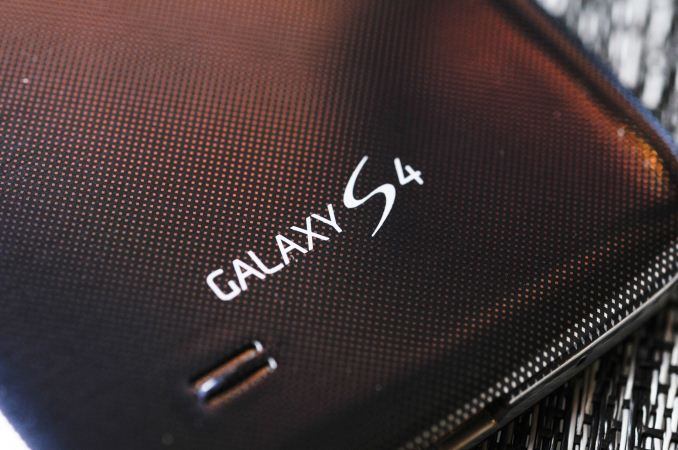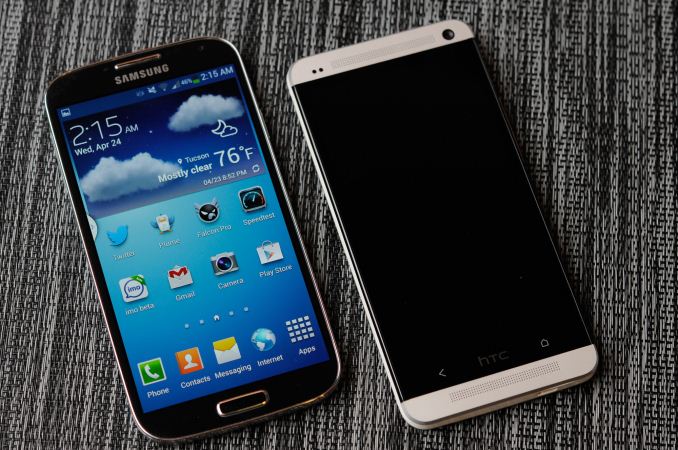Samsung Galaxy S 4 Review - Part 1
by Brian Klug on April 24, 2013 12:01 AM ESTFinal Words
Samsung has done a tremendous job creating a global following not only for its brand, but also for its software. In studying Samsung and its devices it becomes quite clear that although many enthusiasts yearn for pure, unadulterated Android, there are seemingly big pockets of the market who have grown used to (and maybe even desire?) Samsung's TouchWiz user experience. It really is a very clever strategy on Samsung's part. If you deliver products that your users appreciate, and deliver a uniquely different user interface at the same time, you begin to create an appreciation for that user interface as well. All of this flies in the face of what we as reviewers normally seem to prefer, but Samsung's success is proof of the fact that not everyone absolutely detests OEM customized Android.
Samsung's existing user base is likely the easiest to talk to about the Galaxy S 4. Compared to any previous Galaxy S device, the SGS4 is a clear step forward in all of the right areas. The display is higher resolution, the SoC is significantly faster, there's better WiFi (and connectivity depending on what generation of Galaxy S you're talking about) and obviously the Galaxy S 4 runs the absolute latest version of Android. Even on the camera side, Samsung has improved imaging performance over the Galaxy S 3 this generation thanks to its use of a wider aperture lens system. If you're a happy owner of a Samsung Galaxy S/S2/S3, you'll likely be a happy owner of a Galaxy S 4.
It's when you compare the Galaxy S 4 to its chief technical competitor, the HTC One, that the discussion becomes more complicated. HTC and Samsung take very different approaches to nearly every aspect of their flagship smartphones. Whether it's display (LCD vs. Super AMOLED), camera (low light vs. well lit performance), or software (subtle Sense 5 or feature filled TouchWiz), you couldn't pick two more different players in the Android space. So which is better?
It really depends on what you value more. The One's camera delivers better low light performance, while the Galaxy S 4's camera delivers better performance in well lit (e.g. outdoor) scenarios. The One's software customizations are definitely more subtle and out of your way, while Samsung's approach is much more feature overload and in your face. It's difficult to say for sure given our Sprint review unit, but HTC likely gets the slight edge in battery life based on our results here today (although these two devices can be close competitors depending on the workload). Samsung does integrate the faster SoC, despite both the Galaxy S 4 and HTC One shipping the same Snapdragon 600 platform. Samsung and HTC remain on opposite sides of the removable battery/microSD fence, if those two things matter to you then Samsung is the obvious choice. Finally there's a question of how much you value/desire an all-metal smartphone. For some, Samsung's choice in materials is going to continue to be a very big issue.
At the end of the day, the Galaxy S 4 is an evolution of the Galaxy S 3 in pretty much all of the areas you'd expect it to be. Whether or not that's what you wanted in a new Android smartphone is going to vary from one person to the next. The good news is that you at least have a choice.












335 Comments
View All Comments
slatanek - Wednesday, April 24, 2013 - link
same goes for plastic - it can crack and scratch. and it just feels like... well plastic. Samsung phones being one of the worst when it goes to quality feel. Nokia and HTC make the best "feeling" plastic phones I reconslatanek - Wednesday, April 24, 2013 - link
oh, one more thing. materials such as aluminum, glass etc. have a premium feels to them. same for polycarbonate. the difference being how these material age. my friend has an iPhone 4S with a cracked back, but it doesn't look that bad, if anything it has a vintage look and this is how premium materials age. if you have a plastic phone thats scratched or cracked it looks pretty much like garbage. and Samsung is particulalry bad at this - making their phones plastic glossy which means it reflects light in an uneven fashion and it just looks cheap. now bare in mind we're talking about flagships, they just should feel premium. I don't mind having a plastic midrange phone but at highend I expect top notch quality not only from the internals. same applies to cars - a tuned Honda may be as fast as a Ferrari but does it mean it is equally good? I don't think so. And I don't often hear Ferrari owners complaining about leather seats "cause they scratch much more than the regular ones".superflex - Wednesday, April 24, 2013 - link
So you only cracked the back cover. How about the millions of people who dropped their plastic phone and cracked the bezel or non removable shell?Do you really think people only break the removable battery covers?
lopri - Wednesday, April 24, 2013 - link
What other Snapdragon 600 devices? (plural) It's just the S4 and the One. (OK, LG has Optimus G Pro but you didn't see the markings on the chip on it and only ran browser benches with that)Brian Klug - Wednesday, April 24, 2013 - link
I have an LG Optimus G Pro here, so that's three I guess.-Brian
CrystalBay - Wednesday, April 24, 2013 - link
Hi Brian , I would have also like to see a comparison of the external speakers quality. It seems Sammy did not learn from previous Galaxys.Roland00Address - Wednesday, April 24, 2013 - link
From WikipediaAsus Padfone Infinity, HTC One, LG Optimus G Pro, Samsung Galaxy S4 (GT-I9505), ZTE Grand Memo V9815, Xiaomi Mi-2S, Pantech Vega Iron
gnx - Wednesday, April 24, 2013 - link
The Pantech Vega Iron seemed interesting, at least in terms of casing. The soon due Lenovo K900 also is supposedly a metal-alloy, though we'll wait to see.Toss3 - Wednesday, April 24, 2013 - link
Not as thorough as the HTC One review, but the best I've read thus far. THIS is how you write an objective review. Great comparisons, and detailed information about every aspect of the device.UpSpin - Wednesday, April 24, 2013 - link
Well written review.Especially your battery run down and display analysis are one-of-a-kind. Reviews on Engadget or TheVerge test it very subjectively and dim the display to 50% software brightness (which favors OLED because at 50% the OLED display is much darker than the LCD to save power, thus SGS4 scores much longer battery life, because the test is just wrong) You set it to fixed 200nits and test it very objectively.
You also highlight issues occuring with OLED (overheating and thermal issues). Personally I think OLED is the future-proof technology (I also bought a smartphone with an OLED display), but sadly the brightness is nothing spectacular and so the color accuracy. I wouldn't buy a smartphone with OLED again, at the moment.
LCD is just better, even if black isn't true black any longer. That's a small tradeoff, therefor I get outdoor usability, color accuracy and larger sub-pixels.
In the end, one can choose between HTC One (spectacular design, great display, usable camera, usable speakers, smooth and simple software) or the SGS4 (faster SoC which sadly overheats, removable battery, expandable storage, software loaded with gimmick features which sadly slow down the whole smartphone).
Because I won't use the gimmick features, rather just even switch to Cyanogenmod, bought but almost never used the second replacement battery in my current smartphone and the whole battery life improved to at least 3-4 years (my current battery is 3 years old and runs fine), never switched my SD-Card (32GB is plenty), but want it as point-and-shoot replacement and like the look of the HTC One, it's my personal favorit.